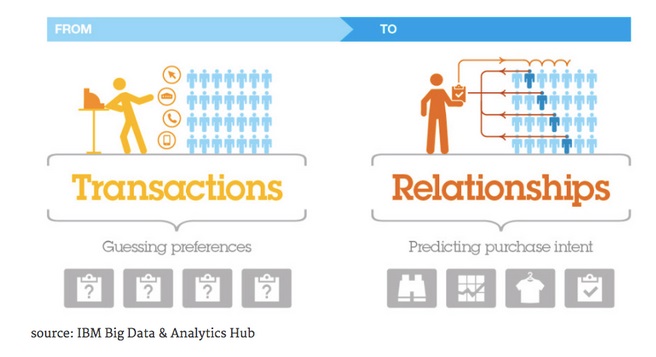A truly effective digital marketing strategy can only exist if we develop relationships with customers along each step of the customer journey. We don’t just need to understand the transactions on that journey but also understand the customers’ intentions at each stage of the journey. See the image below.
But how do we do this? How do we move from simply monitoring transactions to forming relationships? How do we both track and engage with customers? We asked Rob Walker – Managing Director of Xcite Digital – to give us his insight on tracking and engaging with customers.
1 – Isn’t it stating the obvious that businesses should track and engage with their customers?
Yes indeed – and as effectively as possible! But the key thing is that these days there are tools and technologies that can provide much more accurate ways of achieving this. There is no longer any excuse for “guessing preferences” as in the diagram on the left. We have all the tools and technologies to build relationships and predict purchase intent as in the diagram on the right.
2 – So can you tell us a little more about how businesses can do this?
One key development is the level of insight that can now be gained around website traffic. This allows a business to personalise adverts based on where customers are in their buying cycle.
Let’s look at a three examples of different audiences on your website:
i. We can categorise someone who has visited your website, visited a few pages, but completed nothing more, as a prospect. We could then send adverts specifically to this audience on third party sites.
ii. Someone who has gone all the way through to the shopping cart but pulled out at the last minute can be profiled as someone much later in the buying cycle. I.e. they are ready to buy right at this moment – except something put them off so we need to find out what that was then try to turn that user into a buyer.
iii. If one of your visitors completes a goal – whether it is buying something or downloading or signing up (the point being this does not just apply to shopping) – then we can incentivise this audience to buy again from you. Just as importantly we can encourage them to become brand advocates and promote your company to their network of contacts who may also then buy from you.
Once you have built up profiles of your various different audiences you can then work out the right messages you want to communicate, how often, what the goals are etc.
You can go further though… you can also build up these audience profiles on different channels and platforms, for example, you may have an audience on Facebook which can be also be broken up into the different stages of the buying cycle. Our goal is to turn prospects . . . . into suspects . . . .into customers.
For example someone looking for a tea cup may research a range of companies that make tea cups, then realise they want bone china so looks at a range of companies that sell bone china tea cups. Finally the prospect narrows down the options between two companies. The company that has been promoting themselves to the prospect makes them more interested and hence a suspect.
3 – But don’t you think sometimes it can be a bit intrusive to track customers so closely? For example, some people may be a little annoyed or even slightly “freaked out” when targeted adverts start appearing on every website they use!
I can see that sometimes it may seem intrusive, but I am more focused on the people who engage with these tactics so that I can sell more for my clients. But also even from a consumer point of view I think it’s much better to receive an advert specifically to me, rather than a generic message broadcast en masse. My own personal thought process would be: “You’re sending me a tailored messages . . . rather than something irrelevant that wastes my time? Thank you.”
4 – What kind of obstacles can prevent businesses making full use of such strategies?
The main obstacles lie in having the right resources. Too many companies face the issue that even though they are gathering more data than ever, they still struggle to effectively access and utilise this data in a meaningful way.
Data is often held by separate departments in different formats and it can therefore be difficult to coordinate the use of data between different channels. This can result in companies not knowing how different channels influence purchase decisions, and being unable to optimise campaigns accordingly. Our recent blog on attribution addressed this topic in more detail.
In a recent American research – by the CMO Club and Visual IQ – among 223 Chief Marketing Officers (CMOs), around 82% of the CMOs felt unable to accurately measure cross-channel performance.
The most significant reasons for this – as shown in the diagram below – included data being unavailable or incompatible, lack of appropriate tools and technologies, inability to measure cross-channel performance, and lack of in-house skills to implement and maintain omni-channel marketing.
5 – Can you give us an example of how Xcite has helped a company to improve the way they track and engage with their customers?
Venture Photography are the UK’s leading portrait photography company with studios all over the UK and around the world. We were able to combine sales data and Google analytics to define a “travelling radius”, by working out how far people were willing to travel to their nearest photography studio from their home.
We used this data to make sure we advertised within this range, but for people who lived slightly further away we created a range of campaigns to incentivise them with offers and discounts that aimed to reduce the barrier to using Venture Photography.
6 – In what new ways do you think this area might develop further over the next few years?
It’s very difficult to say – without the benefit of a crystal ball, all I can do is suggest a few potential trends and promise to keep updating this blog as new developments happen. My top five predictions are:
- to complement cross channel marketing, companies will communicate with customers via an increasing variety of platforms, including the exploding field of mobile technology and also accessible platforms such as voice recognition and sensors;
- social media will be at the heart of creating personalised customer brand experience and advocacy;
- analytical tools will become even more advanced and streamlined, and able to target advertising in increasingly subtle and sophisticated ways;
- customer relationship management will become increasingly more proactive, with interactive feedback enabling resolution of issues almost before they develop;
- the growth of the Internet of Things will present unforeseen and unprecedented opportunities for creative digital marketing.
Whilst it remains to be seen how the process of tracking and engaging with customers does develop further over the next few years, there is no doubt that further change lies ahead. For now, the key really is to develop the infrastructure, resources and skills to move from transactions to relationships so that we can not only understand the customer journey but direct its path.



